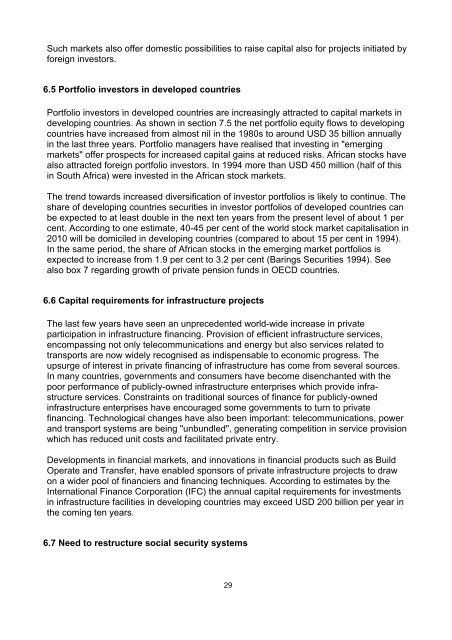Financial sector development - Sida
Financial sector development - Sida
Financial sector development - Sida
Create successful ePaper yourself
Turn your PDF publications into a flip-book with our unique Google optimized e-Paper software.
Such markets also offer domestic possibilities to raise capital also for projects initiated by<br />
foreign investors.<br />
6.5 Portfolio investors in developed countries<br />
Portfolio investors in developed countries are increasingly attracted to capital markets in<br />
developing countries. As shown in section 7.5 the net portfolio equity flows to developing<br />
countries have increased from almost nil in the 1980s to around USD 35 billion annually<br />
in the last three years. Portfolio managers have realised that investing in "emerging<br />
markets" offer prospects for increased capital gains at reduced risks. African stocks have<br />
also attracted foreign portfolio investors. In 1994 more than USD 450 million (half of this<br />
in South Africa) were invested in the African stock markets.<br />
The trend towards increased diversification of investor portfolios is likely to continue. The<br />
share of developing countries securities in investor portfolios of developed countries can<br />
be expected to at least double in the next ten years from the present level of about 1 per<br />
cent. According to one estimate, 40-45 per cent of the world stock market capitalisation in<br />
2010 will be domiciled in developing countries (compared to about 15 per cent in 1994).<br />
In the same period, the share of African stocks in the emerging market portfolios is<br />
expected to increase from 1.9 per cent to 3.2 per cent (Barings Securities 1994). See<br />
also box 7 regarding growth of private pension funds in OECD countries.<br />
6.6 Capital requirements for infrastructure projects<br />
The last few years have seen an unprecedented world-wide increase in private<br />
participation in infrastructure financing. Provision of efficient infrastructure services,<br />
encompassing not only telecommunications and energy but also services related to<br />
transports are now widely recognised as indispensable to economic progress. The<br />
upsurge of interest in private financing of infrastructure has come from several sources.<br />
In many countries, governments and consumers have become disenchanted with the<br />
poor performance of publicly-owned infrastructure enterprises which provide infrastructure<br />
services. Constraints on traditional sources of finance for publicly-owned<br />
infrastructure enterprises have encouraged some governments to turn to private<br />
financing. Technological changes have also been important: telecommunications, power<br />
and transport systems are being "unbundled", generating competition in service provision<br />
which has reduced unit costs and facilitated private entry.<br />
Developments in financial markets, and innovations in financial products such as Build<br />
Operate and Transfer, have enabled sponsors of private infrastructure projects to draw<br />
on a wider pool of financiers and financing techniques. According to estimates by the<br />
International Finance Corporation (IFC) the annual capital requirements for investments<br />
in infrastructure facilities in developing countries may exceed USD 200 billion per year in<br />
the coming ten years.<br />
6.7 Need to restructure social security systems<br />
29

















